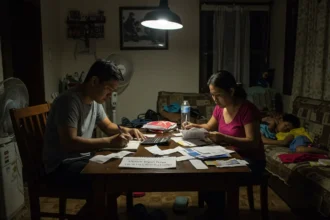In 2025, freelance writing in the Philippines is no longer just a side hustle-it’s becoming a real career path. With the slowdown in traditional BPO hiring, more Filipinos are turning to flexible online jobs, and writing is one of the easiest doors to open. Ang kailangan mo lang? Laptop, internet connection, at willingness to learn.
- ✍️ What is Freelance Writing?
- 💡 Step 1: Decide on Your Writing Niche
- 🛠️ Step 2: Build Your Skills and Portfolio
- 🌐 Step 3: Set Up Your Online Presence
- 💰 Step 4: Learn How to Price Your Work
- 🔎 Step 5: Find Freelance Writing Jobs in the Philippines
- 🤝 Step 6: Build Client Relationships and Grow
- 📈 Bonus Tips for Filipino Writers in 2025
- ❓ Frequently Asked Questions (FAQ)
- ✅ Your Freelance Writing Career Starts Now
Unlike other online careers that demand years of technical experience, writing is something most Pinoys are already familiar with. Mahilig tayong magkuwento, mag-Facebook post, at mag-express ng feelings online. Kaya naman, maraming kababayan ang natututo kung paano gawing income source ang hilig sa pagsusulat.
And here’s the good news: even if you’re a beginner with no experience, you can start small and grow. This article is designed as a beginners guide, a step-by-step roadmap para sa mga gustong subukan kung paano maging freelance writer sa Pilipinas. Whether you’re a fresh grad, a stay-at-home parent, or someone looking for extra income, this guide will help you navigate your first steps in building a writing career online.

✍️ What is Freelance Writing?
Bago tayo sumabak sa mga steps, let’s clear one thing first: ano nga ba ang freelance writing?
In simple terms, it’s when clients-local man o foreign-pay you to write different kinds of content. Hindi ka empleyado ng isang kumpanya; instead, you work per project, per article, or per word, depending sa usapan. That’s why it’s called freelance-may freedom kang pumili ng clients, oras, at kung anong klaseng trabaho ang tatanggapin mo.
Here are some of the most common freelance writing jobs in the Philippines:
-
Blog Writing – articles for websites (lifestyle, travel, health, finance, tech).
-
Copywriting – persuasive content like ads, sales pages, and product descriptions.
-
SEO Content Writing – keyword-rich articles designed to rank on Google (exactly what you’re reading now 😉).
-
Academic/Research Writing – essays, reports, and research-based documents (though be careful, some may not be ethical).
-
Scriptwriting – YouTube, TikTok, or even podcast scripts.
The best part? You don’t need a journalism degree or fancy connections to start. If you can write clear, engaging content and follow instructions, may space ka dito. Many Pinoys begin with small writing gigs-₱200 to ₱500 per article-then gradually scale up as they improve and build experience.
Sa madaling salita: freelance writing is one of the most beginner-friendly online jobs. And because of our strong English skills as Filipinos, may advantage tayo sa global freelancing market.

💡 Step 1: Decide on Your Writing Niche
One of the first decisions you’ll face as a beginner freelance writer in the Philippines is choosing your writing niche. Simply put, a niche is the specific type of content or industry you want to focus on.
Why is this important? Because clients are more likely to hire writers who specialize. Imagine you’re looking for someone to write about fitness and nutrition-you’d naturally prefer a writer who has samples or experience in that area, right? The same applies to blogging, travel, finance, or even tech writing.
Here are some popular freelance writing niches for Filipinos:
-
Lifestyle & Travel – perfect if you love sharing personal experiences, budget tips, or local guides (e.g., “10 Things to Do in Siargao”).
-
Health & Wellness – covers fitness, nutrition, mental health, and medical-related content.
-
Finance & Business – ideal for writers who enjoy topics like saving money, investing, or small business guides.
-
Technology & Gadgets – great for those who keep up with apps, software, and the latest devices.
-
Education & Career – writing about online learning, study hacks, or work-from-home opportunities.
👉 Pro tip: Start with a niche you’re already comfortable with. For example, kung mahilig kang mag-travel, you can write destination guides or reviews of local spots. If you’ve worked in a call center before, you can specialize in career advice or customer service topics. The more authentic your writing feels, the easier it is to build your portfolio and attract clients.
📊 Table 1: Common Freelance Writing Niches
| Niche | Example Topics | Why It Works for Filipinos |
|---|---|---|
| Lifestyle & Travel | “Top 10 Things to Do in Palawan” | Many Pinoys love travel and local culture |
| Health & Wellness | “Beginner’s Guide to Fitness at Home” | Growing demand for health content |
| Finance & Business | “How to Save ₱5,000 a Month” | Practical advice for everyday Pinoys |
| Technology & Gadgets | “Best Budget Smartphones in 2025” | Pinoys are tech-savvy and mobile-first |
| Education & Career | “Tips for Work-from-Home Newbies” | Perfect for the online jobs market |
Don’t worry if you can’t decide on just one niche yet. Many beginners experiment with different topics before settling on their “sweet spot.” What matters is that you start writing and producing samples that show your skills.
In the world of freelance writing jobs in the Philippines, finding your niche is like planting your first seed-it’s the foundation that helps your career grow.

🛠️ Step 2: Build Your Skills and Portfolio
Once you’ve chosen a niche, the next step is to sharpen your skills and create a freelance writing portfolio that will impress clients. Don’t worry-this doesn’t mean you need years of experience or an expensive degree. What you need is proof that you can actually write.
Take Advantage of Free and Affordable Courses
If you’re starting from zero, online learning platforms are your best friend. Websites like Coursera, Skillshare, Udemy, and even free YouTube tutorials can teach you the basics of grammar, writing styles, and SEO content. In the Philippines, you’ll also find local webinars and workshops hosted by writing communities and Facebook groups. Some are free; others are very affordable compared to formal schooling.
Create Writing Samples
Think of writing samples as your audition pieces. Clients will ask, “Can you show me what you’ve written before?” If you don’t have paid work yet, make your own. You can:
-
Publish articles on Medium (free blogging platform).
-
Start your own WordPress or Blogger blog.
-
Simply write sample articles in Google Docs and share the link.
What matters most is that you demonstrate your ability to research, write clearly, and adjust your tone depending on the topic.
Showcase Filipino-Friendly Samples
If you’re based in the Philippines, use it to your advantage. Write about things that international clients might find fresh and unique:
-
A travel piece about Palawan or Siargao.
-
A budget guide on how Filipinos save money while living in Metro Manila.
-
A food article featuring classic Pinoy dishes like adobo or sinigang.
These samples don’t just prove your skills-they also highlight your cultural perspective, something global clients often value.
Build Your First Portfolio
Once you have a few strong samples, organize them into a freelance writing portfolio. This could be a simple Google Drive folder with links, a free website, or a PDF file with 3–5 of your best works. As you land more projects, keep updating your portfolio with real client work.
In the world of freelance writing in the Philippines, your portfolio is your calling card. Even if you’re a beginner, a solid portfolio will make you look credible and help you stand out among hundreds of other applicants.

🌐 Step 3: Set Up Your Online Presence
In today’s digital world, clients won’t just take your word for it-they’ll look you up. That’s why setting up a freelance writing profile online is one of the smartest moves you can make. Think of it as your digital résumé: a place where potential clients can see your skills, writing samples, and work history.
Start with the Right Platforms
Here are some of the most popular sites where Filipino freelancers find opportunities:
-
LinkedIn – A professional network where you can showcase your skills, connect with recruiters, and publish short writing samples.
-
Upwork – One of the largest freelancing marketplaces where clients post jobs daily. Competition is high, but so is the earning potential.
-
Fiverr – Best for creating service packages (“gigs”) like “I will write a 500-word blog post.”
-
OnlineJobs.ph – A platform built specifically for Filipinos, making it easier to find long-term remote clients.
-
Facebook Groups – Communities like Online Filipino Freelancers or Work from Home PH often share job leads and advice.
These platforms are where online jobs in the Philippines thrive, especially for beginners.
Build a Personal Brand
Your online presence isn’t just about listing skills-it’s about presenting yourself as a reliable professional. To do this:
-
Use a clear, professional profile photo (no blurry selfies).
-
Write a short bio/introduction that highlights your niche and strengths. Example: “I’m a freelance writer from the Philippines specializing in lifestyle and travel blogs.”
-
Upload or link your writing samples (from Step 2) so clients can quickly see what you can do.
Optional but Powerful: Create Your Own Blog or Website
If you want to stand out even more, set up a simple blog or website under your own name. It doesn’t need to be fancy-just a few pages where you:
-
Introduce yourself.
-
Upload your portfolio.
-
Publish a few blog posts that show your writing style.
Having your own website positions you as more credible than freelancers who only rely on job boards. It signals to clients that you’re serious about your craft.
In short, building your freelance writing profile is about being visible where opportunities are. When a client Googles your name or checks your profile, they should immediately see professionalism, clarity, and confidence. That’s how you start turning online profiles into real, paying gigs.

💰 Step 4: Learn How to Price Your Work
For many beginners, the hardest question is: “Magkano ba dapat ang singil ko?” Pricing is tricky, but it’s also one of the most important parts of being a freelancer. Charge too little and you’ll burn out; charge too much without the right experience and you’ll scare away potential clients. The key is finding the balance.
Typical Freelance Writing Rates in the Philippines
If you’re just starting out, here’s a quick look at freelance writing rates in the Philippines:
-
Per Word: ₱0.50 to ₱3.00 (common for blog posts and SEO articles).
-
Per Article: ₱200 to ₱500 for 500 words (beginner range).
-
Intermediate to Experienced Writers: ₱1,000 to ₱2,500+ per article, especially for technical or specialized niches.
-
High-Level Copywriters: ₱5,000+ per sales page or marketing copy, depending on expertise.
These numbers vary depending on your niche, client location, and project complexity. Foreign clients usually pay more than local clients, but local gigs can be a good way to practice and build a steady income.
Hourly vs. Per-Project Pricing
-
Hourly Rate – Common on platforms like Upwork. Beginners often start at $3–$5/hour (around ₱150–₱250), while experienced Filipino writers can earn $15–$30/hour.
-
Per Project – Most common for blog posts, web copy, and one-off assignments. Clients like this because it’s predictable, and you can control how fast you work.
👉 Tip: For beginners, it’s often easier to start with per-project pricing, then transition to hourly once you gain confidence and a steady flow of clients.
Pricing Tips for Filipino Freelance Writers
-
Don’t Undersell Yourself – It’s tempting to accept very low rates just to land a client, but charging too little sets the wrong expectation.
-
Research Market Rates – Browse Upwork, Fiverr, and OnlineJobs.ph to see what other freelancers charge.
-
Factor in Time & Effort – A 500-word lifestyle blog is not the same as a 500-word legal or medical article. Price according to difficulty.
-
Raise Rates Gradually – Once you’ve built experience and a good portfolio, increase your rates step by step. Clients will respect you more for valuing your work.
📊 Table 2: Typical Freelance Writing Rates in the Philippines
| Type of Work | Beginner Rate | Experienced Rate | Notes |
|---|---|---|---|
| Per Word | ₱0.50 – ₱1.00 | ₱2.00 – ₱3.00+ | SEO blogs, general articles |
| Per 500-Word Article | ₱200 – ₱500 | ₱1,000 – ₱2,500+ | Specialized topics pay higher |
| Hourly (Upwork/Fiverr) | $3 – $5/hour (₱150–₱250) | $15 – $30/hour (₱800–₱1,500) | Depends on skill and client |
| Copywriting / Sales Pages | ₱1,500 – ₱3,000+ | ₱5,000 – ₱10,000+ | High demand for persuasive writing |
At the end of the day, your writing is a skill-hindi libre ang talento mo. Setting the right price ensures you’re fairly compensated and motivates you to keep improving.

🔎 Step 5: Find Freelance Writing Jobs in the Philippines
Now that you have a portfolio and a profile, it’s time to hunt for actual freelance writing jobs in the Philippines for beginners. The good news? There are plenty of platforms where you can find opportunities-both local and international.
Legit Websites to Start With
Here are some of the most reliable sites where Pinoy freelance writers can land paid work:
-
Upwork – One of the biggest freelancing platforms. Clients post daily, ranging from blog posts to technical writing. Competition is tough, but it’s worth trying because the pay can be good.
-
Fiverr – Here, you create “gigs” or service packages (e.g., “I will write a 1,000-word blog post on travel”). Great for beginners who want to attract clients passively.
-
OnlineJobs.ph – A site built specifically for Filipinos, with many long-term writing jobs from foreign employers. No bidding required; you apply directly.
-
FreelanceWriting.com – Curates job listings from around the web. A good place to discover hidden gems outside the big platforms.
-
ProBlogger Jobs – Well-known for blogging opportunities. Many international clients post here looking for writers who can produce high-quality content.
-
Facebook Groups – Communities like Pinoy Freelancers or Work from Home PH often share real-time job postings, plus tips from experienced freelancers.
👉 Pro tip: Always verify the client before starting any work. If the offer sounds too good to be true, it probably is.
How to Apply and Stand Out
When applying for freelance writing jobs, keep your application simple and direct. Most clients receive dozens of pitches daily, so clarity and professionalism go a long way.
-
Write a Short Cover Letter – Introduce yourself, mention your niche, and explain why you’re a good fit. No need for long stories.
-
Tailor Your Samples – Send writing samples related to the job. If it’s a travel blog, send your Palawan or Boracay piece instead of a finance article.
-
Highlight Your Strengths – For beginners, emphasize reliability: meeting deadlines, being responsive, and following instructions.
-
Keep It Professional – Use polite language, avoid “text speak,” and make sure your email or message is free of grammar errors.
📊 Table 3: Comparison of Freelance Writing Platforms (Step 5: Find Freelance Writing Jobs)
| Platform | Best For | Fees/Deductions | Payout Method | Ease of Entry |
|---|---|---|---|---|
| Upwork | Wide range of global clients | 10% service fee | Payoneer, Direct Bank, PayPal | Moderate (requires strong profile) |
| Fiverr | Service-based gigs (e.g., blog packages) | 20% per gig | PayPal, Payoneer, Bank | Easy (clients come to you) |
| OnlineJobs.ph | Long-term jobs from foreign clients | Subscription (paid by employer) | Direct bank, Payoneer | Beginner-friendly |
| ProBlogger Jobs | Blogging opportunities | None (direct client payment) | PayPal, Bank Transfer | Competitive (quality-focused) |
| Facebook Groups | Quick gigs, networking | None | GCash, Bank, PayPal | Easy but must watch out for scams |
The more targeted and professional your application, the better your chances of landing that first project. Once you secure your first client, everything else gets easier-confidence builds, your portfolio grows, and your earnings start to climb.
🤝 Step 6: Build Client Relationships and Grow
Landing your first client is a huge milestone, but the real secret to how to become a successful freelance writer in the Philippines lies in building strong, long-term relationships. One-off projects can pay the bills, but repeat clients give you stability, steady income, and even referrals.
Always Deliver on Your Promises
Trust is everything in freelancing. If you commit to a deadline, meet it-or better yet, submit early. Double-check your work for grammar, spelling, and formatting errors. Clients will remember the writer who consistently delivers quality without the need for endless revisions.
Communicate Clearly and Professionally
Most freelance writing clients are abroad, so communication is key. Always update them if you’ll need more time, and never leave a client guessing. Clear, polite messages show professionalism and build confidence in your work.
Collect Testimonials and Feedback
After completing a project, don’t be shy to ask for feedback or a short testimonial. A single line like “[Name] delivered well-written articles on time and was easy to work with” can boost your credibility when applying for new jobs. These testimonials are powerful proof for future clients.
Upskill to Reach Higher-Paying Clients
The more you improve, the more you can charge. Many successful Filipino freelance writers eventually specialize in higher-value niches like:
-
SEO content writing – learning how to optimize articles for Google search.
-
Copywriting – persuasive writing for ads, landing pages, and sales funnels.
-
Technical or Business Writing – specialized fields that pay more due to complexity.
Investing in courses, workshops, or even mentorship can push your career forward. Remember: the skills you build today will be the reason you earn more tomorrow.
Consistent quality, professional communication, and continuous learning-that’s the formula for turning freelance writing from a side hustle into a full-time, rewarding career.
📈 Bonus Tips for Filipino Writers in 2025
The freelance writing landscape in the Philippines keeps evolving. To thrive in 2025 and beyond, here are a few extra tips that can make your journey smoother and safer.
1. Watch Out for Scams
Sadly, not every “job offer” is legit. Be cautious of clients who:
-
Offer unrealistically high pay for very little work.
-
Refuse to sign even a simple contract.
-
Ask you to work for “free samples” without any guarantee.
Rule of thumb: if it sounds too good to be true, it probably is. Protect your time and effort. Always ask for clear agreements before starting any project.
2. Join Filipino Freelancer Communities
Working online can feel isolating, but you don’t have to do it alone. Join groups like Online Filipino Freelancers, Freelance Writers Philippines, or Work from Home PH on Facebook. These communities are great for:
-
Networking with fellow writers.
-
Learning new strategies.
-
Getting referrals and job leads.
-
Finding moral support from people who understand the freelancing grind.
3. Use Secure Payment Methods
When dealing with clients abroad, reliable payment channels are a must. The most common ones for Filipino freelance writers are:
-
PayPal – Widely accepted, though it has fees.
-
Payoneer – Great for receiving payments directly from platforms like Upwork.
-
GCash – Convenient for local transfers, especially when clients are also based in the Philippines.
Always clarify payment terms before you begin-how much, when, and through which platform.
4. Manage Your Time Wisely
Freelancing offers flexibility, but that doesn’t mean working without structure. Create a daily routine, set work hours, and stick to deadlines. Remember, you’re your own boss now, so discipline is your strongest tool.
Tip: Use simple productivity apps like Google Calendar, Trello, or even just a notebook to track deadlines and client tasks.
Freelancing is full of opportunities, but also challenges. With the right mindset and these bonus tips, you’ll not only survive-you’ll thrive as a Filipino freelance writer in 2025.
❓ Frequently Asked Questions (FAQ)
1. Can I be a freelance writer without experience in the Philippines?
Yes! Many Filipino freelance writers start with zero experience. The key is to create writing samples, build a small portfolio, and apply to beginner-friendly platforms. Clients are more interested in seeing your actual writing than your degree or work history.
2. How much do beginner freelance writers earn in the Philippines?
Rates vary, but most beginners start at around ₱200–₱500 per article or ₱0.50–₱1.00 per word. As you gain experience and improve your skills, you can raise your rates to ₱1,000 or more per article. Foreign clients often pay higher than local ones.
3. What skills do I need to succeed as a freelance writer?
At the very least, you need good grammar, clear communication, and the ability to follow client instructions. Over time, learning SEO writing, copywriting, and content marketing can help you attract better-paying clients.
4. Is freelance writing a full-time career in the Philippines?
Yes. Many Filipinos have turned freelance writing into a full-time career. It may start as a side hustle, but with consistent clients and higher-paying projects, it can eventually replace a traditional 9-to-5 income.
5. How do I get paid as a freelance writer in the Philippines?
Most clients pay through PayPal, Payoneer, Wise, or direct bank transfers. Local clients may use GCash or bank deposits. Always clarify payment terms before starting a project, and avoid clients who delay or avoid payment agreements.
✅ Your Freelance Writing Career Starts Now
Freelance writing isn’t just another “online racket”-it’s a real career path that thousands of Filipinos are already thriving in. The tools are within your reach, the platforms are open, and the demand for good content has never been higher.
Yes, the start can feel intimidating. You might worry about competition, low rates, or not being “good enough.” But remember this: every successful Filipino freelance writer began exactly where you are-nervous, unsure, but willing to try. The difference between those who made it and those who didn’t? Action.
If you take the first step today-whether it’s creating a sample article, setting up your profile, or applying for your first small project-you’re already moving closer to building a flexible and rewarding career online.
The opportunities are real. The income is possible. And the lifestyle-working from home, having more time for family, or even traveling while earning-is within your grasp.
Your journey as a freelance writer starts now. Open your laptop, put your ideas into words, and hit “send” on that first application. Who knows? Your very first client could be waiting for you today.










